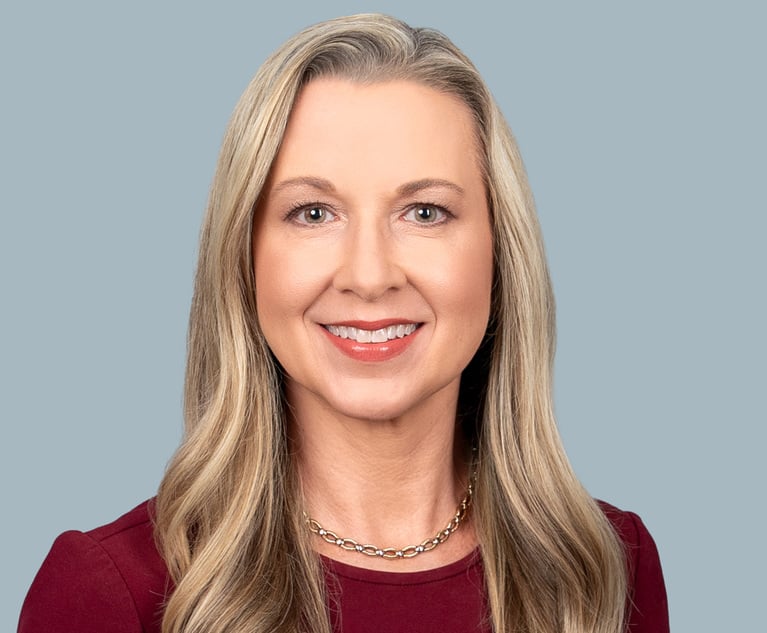 American International Group office in downtown New York City. Photo: Shutterstock
American International Group office in downtown New York City. Photo: ShutterstockLegal Department Leak Leads to Insider Trading Charges Against AIG Employee
In two separate, unrelated complaints the SEC is cracking down on misconduct in the legal department and the compliance world.
February 20, 2020 at 05:56 PM
4 minute read
Insider trading charges against a former legal department worker at an American International Group Inc. subsidiary shows how careful in-house law departments must be in guarding their confidential information.
The U.S. Securities and Exchange Commission on Thursday said it reached a consent agreement with Jon Aronson, a former senior administrative assistant in the subsidiary's legal department. Aronson could not be reached for comment Thursday.
The commission alleged that Aronson learned details about AIG's 2018 merger with Validus Holdings and shared them with his father, Elliet Aronson. Both men, who live in Massachusetts, bought Validus stock.
The son had second thoughts and sold his shares before the merger closed, and advised his father to also sell, according to the complaint filed in U.S. District Court in Manhattan. But the father kept his shares, earning a profit of $20,310.
Both men signed consent agreements that permanently enjoin them from violating insider trading laws in the future. Each man agreed to pay $20,310 in penalties. In addition, the father agreed to pay another $20,310 in disgorgement of his profits.
The two men were represented by Robert Heim of Tarter Krinsky & Drogin in New York. Heim told Corporate Counsel on Thursday that both men "settled the allegations without admitting or denying wrongdoing, and are hoping to put the matter behind them."
The commission also has been busy delving into compliance department conduct. In a separate and unrelated complaint, it has charged two chief compliance officers for breaching their fiduciary duty and defrauding their clients at Criterion Wealth Management Insurance Services Inc.
The complaint, filed last week in U.S. District Court for the Central District of California, accuses Criterion and its two co-owners and investment advisers at the time, Robert Gravette and Mark MacArthur, of failing to disclose that they were receiving side commissions when they invested clients' money in private real estate investment funds. Gravette also served as Criterion's chief compliance officer.
The firm and the defendants reside in Santa Clarita, California. Calls and emails to both men and the firm were not returned Thursday.
The complaint, filed in U.S. District Court for the Central District of California, said they profited over $1 million. It added that for two of the funds, this undisclosed compensation arrangement resulted in reduced investment returns for the defendants' clients.
MacArthur also served as chief investment officer until mid-2016 when he became an independent contractor. He is now president and chief compliance officer of M2 Financial LLC, which he formed in mid-2016.
The commission said the two men "owed their clients—who entrusted them with the discretionary management of [their clients'] money—a fiduciary duty to act with loyalty, fairness, and good faith." It called the side commissions "a glaring conflict of their [clients'] financial interest."
Given the two men's backgrounds, the commission found, "Gravette and MacArthur's failure to disclose their obvious conflicts of interest was willful, knowing, intentional, or reckless."
The complaint seeks permanent injunctions against future violations, disgorgement and prejudgment interest, and civil penalties from all three defendants.
The complaint said that during a 2014 review by an outside compliance consultant, the firm did not disclose the side commissions that represented a substantial portion of Criterion's income.
The consultant said the firm had not been complying with a requirement for annual compliance reviews nor had it tailored its policies to fit the needs of their business. The consultant also pointed out that Criterion was still using a 2008 compliance manual that had not been updated, and that key topics were missing from its written policies and procedures.
When commission staff examined Criterion in 2016, the firm "had not implemented many of the compliance consultant's recommendations." The complaint said the company still had not updated its policies and procedures, and it was still using the 2008 compliance manual.
This content has been archived. It is available through our partners, LexisNexis® and Bloomberg Law.
To view this content, please continue to their sites.
Not a Lexis Subscriber?
Subscribe Now
Not a Bloomberg Law Subscriber?
Subscribe Now
NOT FOR REPRINT
© 2025 ALM Global, LLC, All Rights Reserved. Request academic re-use from www.copyright.com. All other uses, submit a request to [email protected]. For more information visit Asset & Logo Licensing.
You Might Like
View All
Ex-Six Flags CLO Lands New C-Suite Post—This Time as HR Chief

Trump Mulls Big Changes to Banking Regulation, Unsettling the Industry

As AI-Generated Fraud Rises, Financial Companies Face a Long Cybersecurity Battle

After Fining Investment Firms Billions for Lost Text Messages, Regulators Turn Scrutiny to Audio Recordings
Trending Stories
- 1'Pull Back the Curtain': Ex-NFL Players Seek Discovery in Lawsuit Over League's Disability Plan
- 2Tensions Run High at Final Hearing Before Manhattan Congestion Pricing Takes Effect
- 3Improper Removal to Fed. Court Leads to $100K Bill for Blue Cross Blue Shield
- 4Michael Halpern, Beloved Key West Attorney, Dies at 72
- 5Burr & Forman, Smith Gambrell & Russell Promote More to Partner This Year
Who Got The Work
Michael G. Bongiorno, Andrew Scott Dulberg and Elizabeth E. Driscoll from Wilmer Cutler Pickering Hale and Dorr have stepped in to represent Symbotic Inc., an A.I.-enabled technology platform that focuses on increasing supply chain efficiency, and other defendants in a pending shareholder derivative lawsuit. The case, filed Oct. 2 in Massachusetts District Court by the Brown Law Firm on behalf of Stephen Austen, accuses certain officers and directors of misleading investors in regard to Symbotic's potential for margin growth by failing to disclose that the company was not equipped to timely deploy its systems or manage expenses through project delays. The case, assigned to U.S. District Judge Nathaniel M. Gorton, is 1:24-cv-12522, Austen v. Cohen et al.
Who Got The Work
Edmund Polubinski and Marie Killmond of Davis Polk & Wardwell have entered appearances for data platform software development company MongoDB and other defendants in a pending shareholder derivative lawsuit. The action, filed Oct. 7 in New York Southern District Court by the Brown Law Firm, accuses the company's directors and/or officers of falsely expressing confidence in the company’s restructuring of its sales incentive plan and downplaying the severity of decreases in its upfront commitments. The case is 1:24-cv-07594, Roy v. Ittycheria et al.
Who Got The Work
Amy O. Bruchs and Kurt F. Ellison of Michael Best & Friedrich have entered appearances for Epic Systems Corp. in a pending employment discrimination lawsuit. The suit was filed Sept. 7 in Wisconsin Western District Court by Levine Eisberner LLC and Siri & Glimstad on behalf of a project manager who claims that he was wrongfully terminated after applying for a religious exemption to the defendant's COVID-19 vaccine mandate. The case, assigned to U.S. Magistrate Judge Anita Marie Boor, is 3:24-cv-00630, Secker, Nathan v. Epic Systems Corporation.
Who Got The Work
David X. Sullivan, Thomas J. Finn and Gregory A. Hall from McCarter & English have entered appearances for Sunrun Installation Services in a pending civil rights lawsuit. The complaint was filed Sept. 4 in Connecticut District Court by attorney Robert M. Berke on behalf of former employee George Edward Steins, who was arrested and charged with employing an unregistered home improvement salesperson. The complaint alleges that had Sunrun informed the Connecticut Department of Consumer Protection that the plaintiff's employment had ended in 2017 and that he no longer held Sunrun's home improvement contractor license, he would not have been hit with charges, which were dismissed in May 2024. The case, assigned to U.S. District Judge Jeffrey A. Meyer, is 3:24-cv-01423, Steins v. Sunrun, Inc. et al.
Who Got The Work
Greenberg Traurig shareholder Joshua L. Raskin has entered an appearance for boohoo.com UK Ltd. in a pending patent infringement lawsuit. The suit, filed Sept. 3 in Texas Eastern District Court by Rozier Hardt McDonough on behalf of Alto Dynamics, asserts five patents related to an online shopping platform. The case, assigned to U.S. District Judge Rodney Gilstrap, is 2:24-cv-00719, Alto Dynamics, LLC v. boohoo.com UK Limited.
Featured Firms
Law Offices of Gary Martin Hays & Associates, P.C.
(470) 294-1674
Law Offices of Mark E. Salomone
(857) 444-6468
Smith & Hassler
(713) 739-1250






